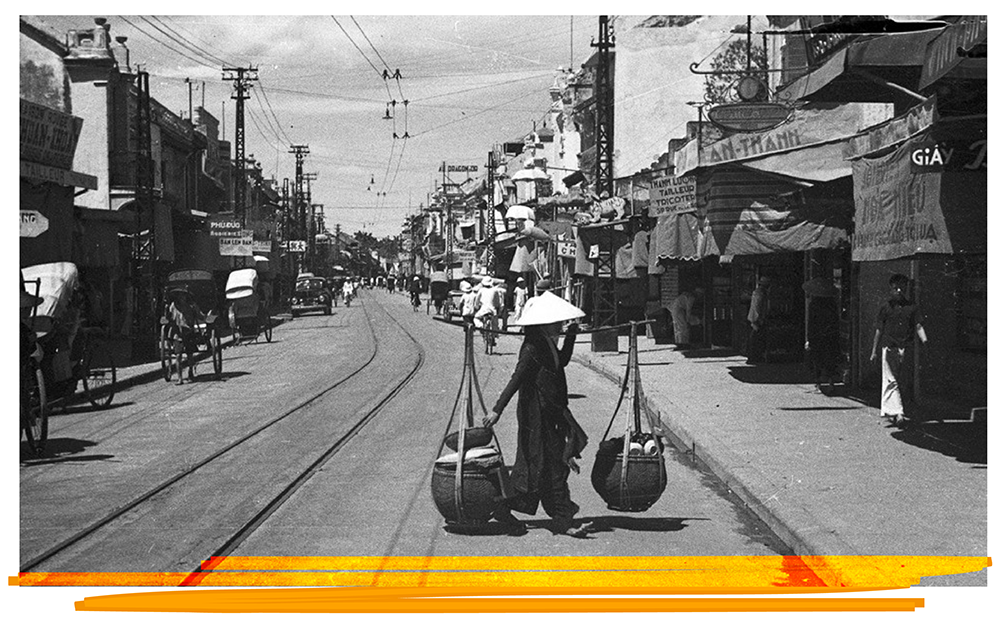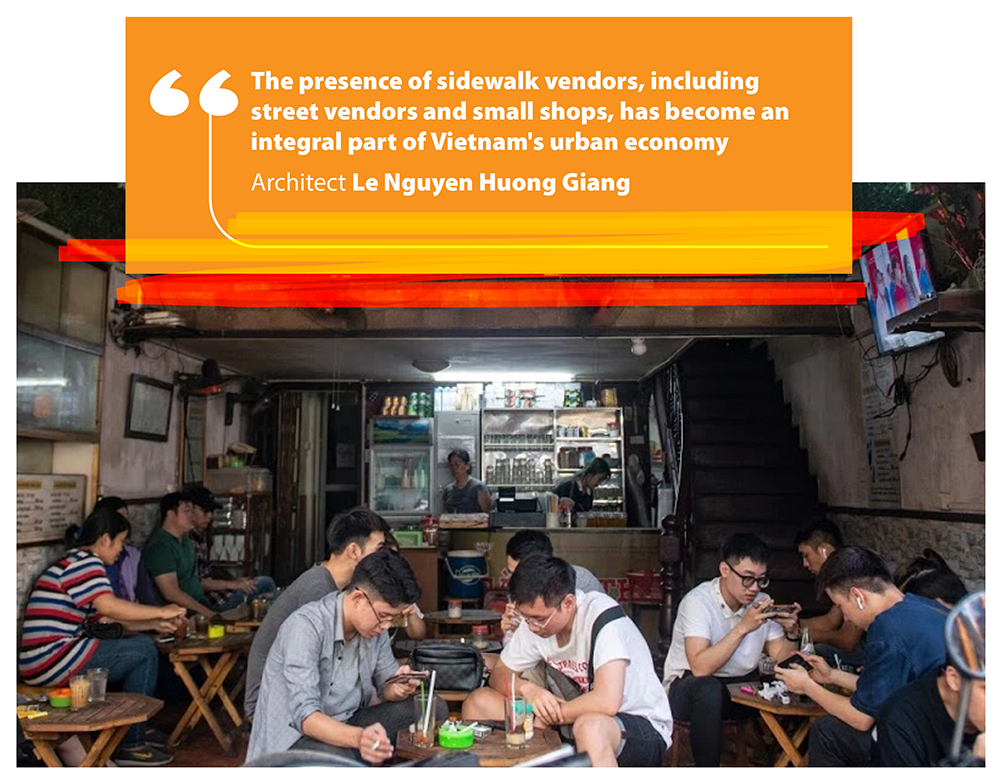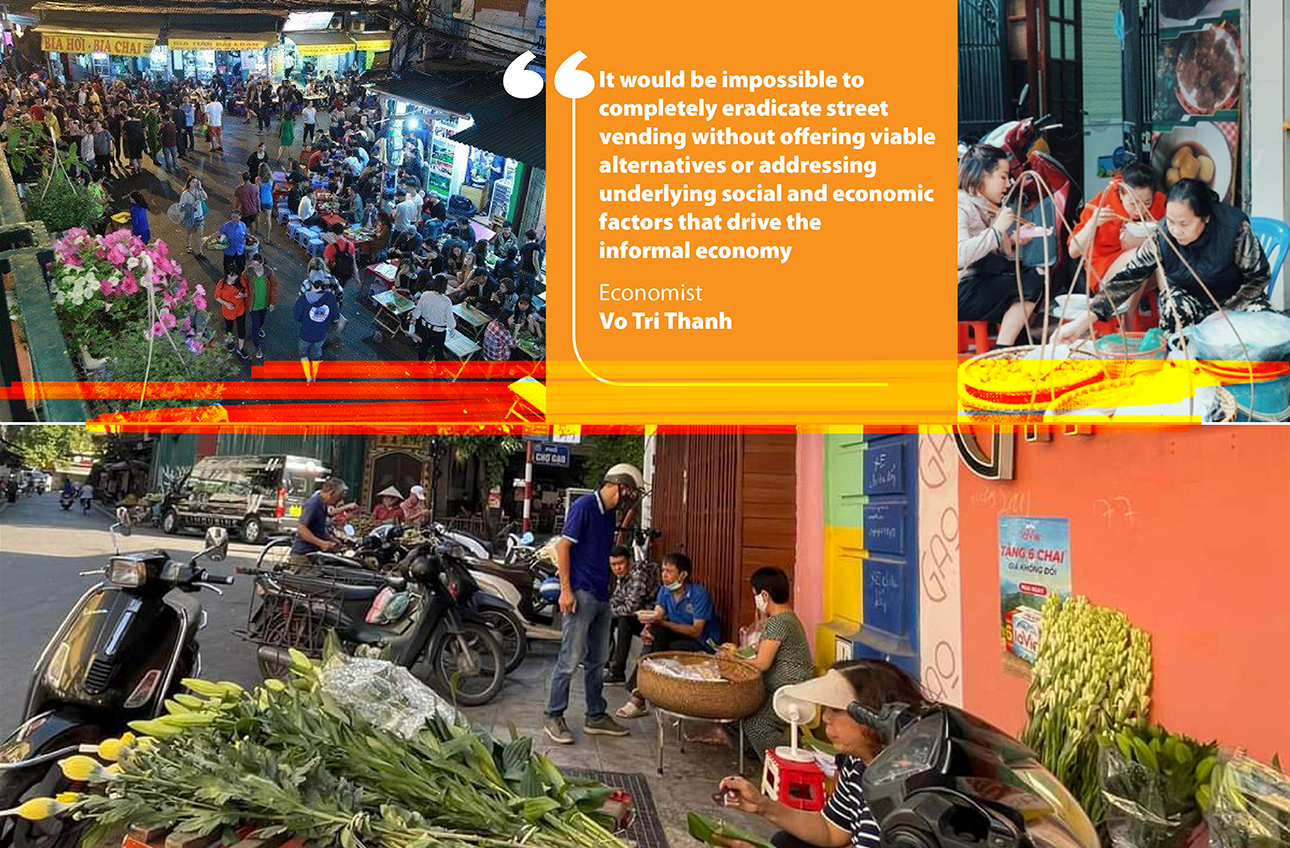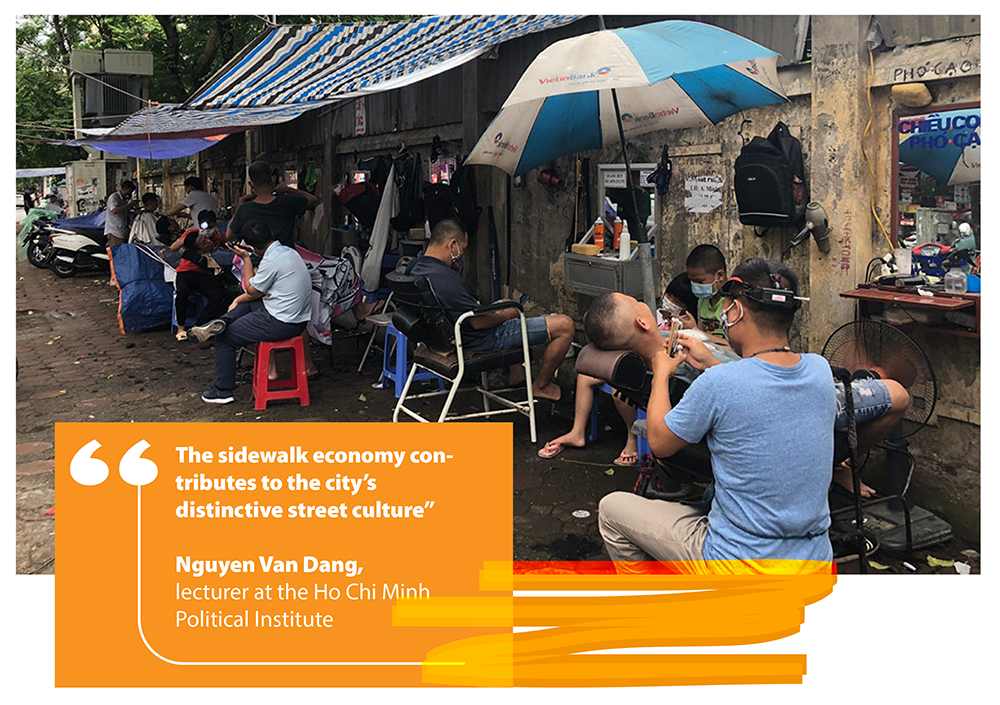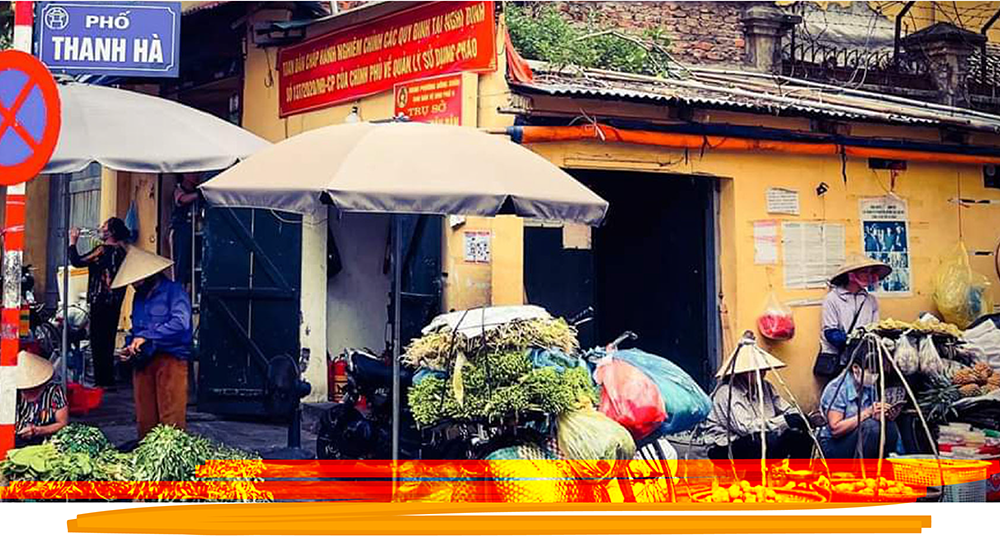Like many cities in Vietnam, Hanoi has a vibrant sidewalk economy characterized by a wide range of informal economic activities on the pavement.
The sidewalk economy in Hanoi includes street vendors, small food stalls, makeshift cafes, shoe repair shops, clothes alteration services, and various informal businesses.
Architect Le Nguyen Huong Giang said these activities often take place on the sidewalks due to the lack of affordable commercial space and limited opportunities for low-income individuals to start formal businesses.
“The presence of sidewalk vendors, including street vendors and small shops, has become an integral part of Vietnam's urban economy. This phenomenon is regarded as a cultural aspect and a defining feature of the local urban landscape,” said Giang.
Nguyen Van Dang, a lecturer at the Ho Chi Minh Political Institute, explained that limited formal job opportunities, a large working-age population, and cultural preferences for shopping in informal settings have created the right conditions for the sidewalk economy to thrive.
Vietnam is currently experiencing a demographic dividend period, characterized by a significant proportion of the population being of working age, which is twice as large as the non-working age population, noted a report jointly conducted by the General Statistics Office and the International Labor Organization (ILO).
As a result, a substantial portion of the working-age population enters the labor market, accounting for approximately 75% of the total labor force each year, the report added.
While the economy is undergoing a transitional phase, the formal sector has not yet been able to absorb the entire workforce. “Limited social welfare conditions and the lack of secure income opportunities in the formal sector mean that those who find it difficult to compete in the labor market often turn to the sidewalk economy as an alternative means of livelihood,” said Dang from the Ho Chi Minh Political Institute.
Statistics show that an estimated 33.6 million workers are engaged in the informal sector, accounting for 68.5% of the total employed population. While the rate of informal activity in Vietnam is relatively lower compared to some neighboring countries such as Cambodia (89.4%), Indonesia (81%), and Myanmar (80.1%), it is still relatively high compared to many countries worldwide.
The income gap between informal and formal workers is evident, with informal workers earning an average of VND4.4 million from their main job in 2021, which is only about half of the income earned by formal workers ( VND8.2 million).
“This income gap highlights the financial challenges faced by those engaged in informal employment and underscores the need to improve economic opportunities and income security in the informal sector,” noted the GSO.
In Hanoi, while the rate remains well below the national average, it was still deemed high at 56.1% in 2021.
“The continued existence of the sidewalk economy, however, is not solely driven by individuals occupying public spaces for personal gains," said Dang.
He pointed to the enduring habit of city dwellers who have not given up their preference for sidewalk shopping.
This convenience-oriented mindset entails the ability to simply pull over to the roadside to purchase goods, rather than visiting shopping centers or supermarkets as in other countries. Thus, “the sidewalk economy in Vietnam represents a unique combination of these two dimensions, and contributes to the city’s distinctive street culture,” he continued.
Nguyen Mai Trang, a Hanoi resident, noted the presence of sidewalk shops is deeply ingrained in the capital's history and cherished by generations of urban dwellers, including herself.
While acknowledging that these establishments may sometimes compromise urban aesthetics and pose food hygiene and safety risks, they remain a captivating attraction for both domestic and international tourists. “This distinct charm has appealed to foreign tourists,” Trang said.
However, echoing the view of others that the convenience of stopping at sidewalk vendors has become an ingrained habit for Hanoi residents that is hard to break, Trang suggests that authorities at all levels in Hanoi should reasonably enforce regulations to preserve the "sidewalk economy" as a distinctive feature of the capital while ensuring the overall urban aesthetics of the city.
Dang Van Thang, a resident of Ba Dinh District, sees street vending as a result of people's livelihoods during challenging times in the country's history. Over time, it has evolved into a convenient shopping habit for the local people. The convenience of the "sidewalk economy" is evident, as people can easily find essential items without having to visit markets or supermarkets.
“Given the distinct feature of the sidewalk economy, it would be another key factor in promoting the development of tourism in the area,” Thang said.
It should be noted, however, that the sidewalk economy also poses challenges in urban planning, traffic congestion, and pedestrian accessibility. The narrow sidewalks in Hanoi are often crowded with vendors and parked motorbikes, making it difficult for pedestrians to stroll.
City authorities have made efforts to regulate and manage the sidewalk economy by conducting regular sidewalk clearance campaigns to restore pedestrian space.
However, similar to efforts from Ho Chi Minh City to address the presence of street vendors, these attempts have proven unsuccessful given the high social demands and needs of the sidewalk economy.
“It would be impossible to completely eradicate street vending without offering viable alternatives or addressing underlying social and economic factors that drive the informal economy,” said economist Vo Tri Thanh.
To address this issue, Thanh suggested that major cities should designate specific streets in downtown areas for sidewalk vending where encroachment is not allowed. Meanwhile, in peripheral neighborhoods where it would have minimal impact on urban operations, a more flexible approach can be taken, allowing sidewalk businesses within designated zones and time frames while still protecting the livelihoods of certain groups.
"By implementing such measures, the sidewalk economy would be developed and regulated more systematically, orderly, and civilized while mitigating any shortcomings or issues that may arise. This approach follows the successful practices of advanced countries in managing their pavement economies," he noted.
Phung Hoang Anh, a cultural researcher, highlights the multifaceted and intricate cultural significance of Hanoi's sidewalks.
With Hanoi's rapid development, the sidewalks have evolved to serve multiple functions, including a crucial economic role. “Considering its cultural implications, the economic aspect is inseparable from the businesses operating on Hanoi's sidewalks as they generate revenue,” Anh said.
Economist Nguyen Minh Phong told The Hanoi Times that, it is an integral part of the socio-economic fabric of Vietnam, particularly in Hanoi. It is also a valuable resource for macro- and microeconomic development, contributing to both the improvement of individual incomes and the enhancement of Vietnam's urban landscape.
Phong suggests that the term "urban sidewalk aesthetics" alone may not fully capture the valuable aspects of the "sidewalk economy." When organized effectively, these activities can contribute to the visual beauty of the streets. Successful models have been implemented in countries such as Thailand or Singapore, where well-decorated shops create a festive atmosphere.
“These approaches attract a significant number of tourists, enhancing both the aesthetic appeal and the economic benefits,” Phong said.
In recent years, there have been several initiatives aimed at formalizing and integrating the street economy into the city's urban planning. In 2022, the Hanoi People's Committee assigned Hoan Kiem District to establish "street food zones" where vendors can operate legally and more orderly.
As part of the initiative, five streets have been chosen to facilitate sidewalk businesses. These streets include Hai Ba Trung, Ly Thuong Kiet, Tran Hung Dao, Le Phung Hieu, and a section of Phung Hung (stretching from Le Van Linh to Hang Vai, and Nguyen Quang Bich near the East Gate).
In early June, Secretary of the Hanoi Party Committee Dinh Tien Dung issued a directive urging districts to take bold steps in piloting the planning of designated sidewalk rental areas to accommodate the livelihoods of those who rely on sidewalk businesses. Recognizing the close connection between roadways, sidewalks, and people's livelihoods, he emphasized the importance of considering the urban economy in this context.
This has prompted urban districts to conduct comprehensive reviews and compile reports identifying specific streets that meet certain criteria, such as sidewalk width and condition, which can be used temporarily for trading goods.
Three districts, namely Hai Ba Trung, Dong Da, and Tay Ho, have proposed using sidewalks for business purposes. This approach is expected to soon lead to a more methodical, disciplined and civilized development of the sidewalk economy. It will create a space for locals to spend time and enjoy a sense of fun and relaxation while attracting domestic and foreign tourists to experience the city's unique services, culture and cuisine.




